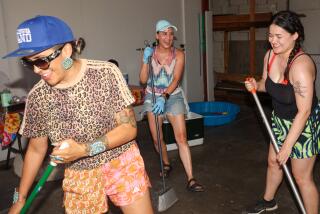Native voices: Indian perspectives are focus of UCLA archive’s film fest
- Share via
The new UCLA Film and Television Archive series “Through Indian Eyes: Native American Cinema” shines a spotlight on what acclaimed Cheyenne-Arapaho director Chris Eyre describes as the “one of the last cinematic frontiers left.”
The series opens Saturday at the Billy Wilder Theater with Eyre’s debut feature, the 1998 road comedy “Smoke Signals,” the first commercially released American feature written, directed and co-produced by Native Americans. It will be shown along with his 1994 short “Tenacity.”
Eyre is encouraged by the progress that’s been made since “Smoke Signals.”
“We are making movies in more numbers than ever, and there are more Native filmmakers than ever,” said Eyre, chairman of the film department at Santa Fe University of Art and Design.
He believes the commercial and critical success of “Smoke Signals” galvanized aspiring directors. “I have seen in the past 15 years a huge volume of Native American filmmakers that are making independent film.”
Every tribe has its own voice, he noted. “When you talk about 565 tribes, how can you say this is who Native people are,” said Eyre. “I am really proud of the fact that Native film is eclectic and enigmatic, because there is no one filmmaker that can say this is who Native people are. We are trying to break ourselves out of this box.”
Myriad tribal communities from the U.S. and Canada, including Navajo, Sioux, Seminole, Mohawk, Cree and Inuit, are represented in the two-month festival.
“What is so important for me as part of this whole retrospective is it gives audiences such a broad view of who we are as a people,” said Valerie Red-Horse, a Cherokee filmmaker and series co-curator.
She feels the festival can help put to rest the racist, demeaning images of Native Americans that have permeated films and television for more than a century.
Native Americans “don’t have balanced images in the media,” she said, noting the controversy over the Washington Redskins’ team name and mascot, which many consider racist. “It really marginalizes who we are.”
Red-Horse approached archive head Jan-Christopher Horak about doing a small retrospective of films directed by Native American UCLA alum. Her timing was perfect — Horak had been wanting to mount a series exploring Native American cinema.
“I said, ‘Let’s do a real series, a big series,’ and that’s how it started,” he said.
And when he began doing research for the festival, Horak acknowledged that he was “shocked” at the depth of filmmaking in Native American communities.
“The interesting thing is that there are comedies, dramas, and there are horror films,” said Horak, adding that the narrative films, documentaries and shorts explore such topics as cultural identity, foster-family issues, alcoholism, racism, genocide and even casinos.
Red-Horse has two films in the festival: “Naturally Native,” screening Nov. 14, a 1998 drama about three American Indian sisters, raised separately in foster families, who encounter prejudice and resistance when they attempt to start an organic cosmetics line, and her 2002 PBS documentary “True Whispers,” screening Nov. 23, which chronicles Navajo code talkers during World War II.
Several of the filmmakers will be appearing at the festival, including Eyre and Red-Horse.
Though the majority of the movies spans the last 25 years, the retrospective is screening three early silent films Nov. 12 — the recently discovered 1920 “The Daughter of the Dawn,” featuring a cast of Kiowas and Comanches; 1894’s “Buffalo Dance,” which some historians believe may be the first filmed appearance of Native Americans; and 1910’s “White Fawn’s Devotion,” directed by James Young Deer, thought to be the first Native American director.
“Through Indian Eyes” also features panel discussions and a tribute Oct. 24 to the Sundance Institute’s Native American and Indigenous Program, which is celebrating its 20th anniversary this year. The event also features a screening of the 2014 Sundance hit comedy “Drunktown’s Finest,” directed by Navajo Sydney Freeland, that revolves around a transgender character in the Miss Navajo competition.
Most of the films in “Through Indian Eyes” have not received commercial distribution, but it hasn’t been for lack of trying.
Among those is Canadian Mohawk filmmaker Shelley Niro, who couldn’t get commercial distribution for “Kissed by Lightning,” her 2009 drama about a Mohawk painter who is haunted by the death of her husband.
“I think people are afraid,” said Niro, addressing the reasons why there was resistance to her film. “They don’t want to know the truth about the history of America. People don’t really want to step into those waters.”
These films, though, do get seen by Native Americans.
“There is this whole culture of films that are played in tribal casinos and at reservations and Native American film festivals,” said Eyre. “So there are community outlets for these movies. The real goal is to get the work seen in the mainstream media.”
Twitter: @mymackie
------------
‘Through Indian Eyes: Native American Cinema’
Where: UCLA Film & Television Archive, Billy Wilder Theater, 10988 Wilshire Blvd., Los Angeles
When: Saturday-Dec. 15
Tickets: $9 general admission; $8 students and seniors; $10 online advance purchase.
Info: https://www.cinema.ucla.edu
‘Through Indian Eyes: Native American Cinema’
Where: UCLA Film & Television Archive, Billy Wilder Theater, 10988 Wilshire Blvd., Los Angeles
When: Oct. 4-Dec. 15
Tickets: $9 general admission; $8 students and seniors; $10 online advance purchase.
Info: https://www.cinema.ucla.edu
More to Read
Only good movies
Get the Indie Focus newsletter, Mark Olsen's weekly guide to the world of cinema.
You may occasionally receive promotional content from the Los Angeles Times.











